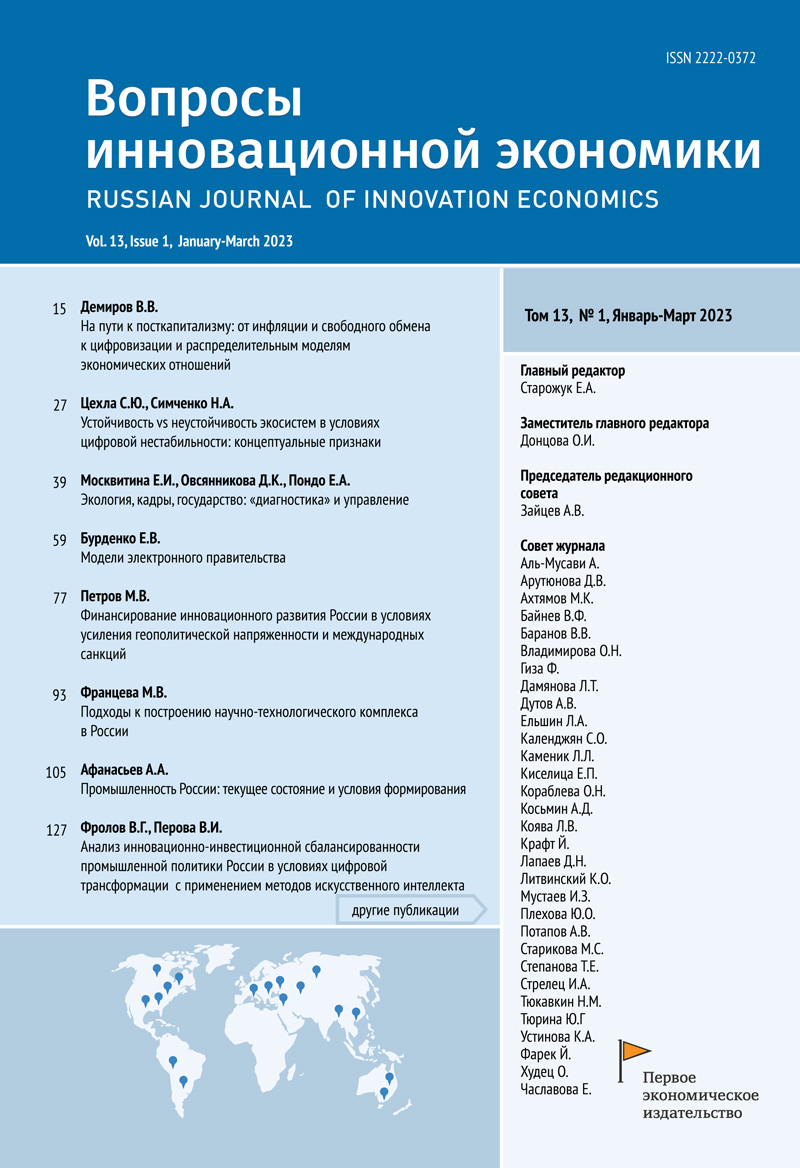Модели электронного правительства
- Авторы: Бурденко Е.В.1
-
Учреждения:
- РЭУ им. Г.В. Плеханова
- Выпуск: Том 13, № 1 (2023)
- Страницы: 59-76
- Раздел: Статьи
- URL: https://journals.eco-vector.com/2222-0372/article/view/608039
- DOI: https://doi.org/10.18334/vinec.13.1.117234
- ID: 608039
Цитировать
Полный текст
Аннотация
Проводя исследование применения цифровых технологий для предоставления государственных услуг мы хотели обобщить положительный опыт, накопленный в разных странах мира. Для решения этой задачи были рассмотрены сформировавшиеся в мире 4 модели электронного правительства. Показаны особенности каждой модели на примере стран, которые используют модель электронного правительства. В рамках каждой модели был проведен ретроспективный анализ внедрения информационно-коммуникационных технологий для предоставления государственных услуг в отдельных странах. В рамках англо-американской модели рассмотрен опыт США, Канады, Великобритании. В рамках европейской модели представлена общая информация по Европейскому союзу. В рамках азиатской модели рассмотрен опыт Южной Кореи, Сингапура, Китая и Японии. Более подробно проведено исследование внедрения электронного правительства в России. Выявлены факторы, оказывающие влияние на формирование каждой модели. Результаты, проведенного исследования, представляют интерес для ученых, занимающихся проблемами применения цифровых технологий в области предоставления государственных услуг
Ключевые слова
Об авторах
Елена Викторовна Бурденко
РЭУ им. Г.В. Плеханова
Email: Burdenko-EV@yandex.ru
почетный работник высшего профессионального образования, доцент, кандидат экономических наук, доцент кафедры Политической экономии и истории экономической науки
Список литературы
- 1. 50-Year Footprints of Korean e-Government 1967-2017. Ministry of the Interior and Safety. 2017. [Электронный ресурс]. URL: https://ssproxy.ucloudbiz.olleh.com/v1/AUTH_43bef30e-e040-499e-86d0-70552f8bf804/CDNStorage/upload/attach/2022/03/07/c9cd4758-dad1-4b4e-bc79-b8b2c7080d9b.pdf (дата обращения: 01.02.2023).
- 2. Baporikar, Neeta, editor. Governance as a Catalyst for Public Sector Sustainability. USA: IGI Global. - 2023. [Электронный ресурс]. URL: https://doi.org/10.4018/978-1-6684-6966-8 (дата обращения: 12.01.2023).
- 3. Bundesportal. Электронное правительство ФРГ. [Электронный ресурс]. URL: https://verwaltung.bund.de/ (дата обращения: 01.02.2023 г.).
- 4. Chen L., Aklikokou A. K. Relating e-government development to government effectiveness and control of corruption: a cluster analysis // Journal of Chinese Governance. – 2019. – № 6(1). – p. 155–173.
- 5. Department of Economic and Social Affairs Public Institutions. United Nations. [Электронный ресурс]. URL: https://publicadministration.un.org/en/ (дата обращения: 01.02.2023 г.).
- 6. Digital Government Strategy. 2012. [Электронный ресурс]. URL: https://www.state.gov/digital-government-strategy/ (дата обращения: 01.02.2023 г.).
- 7. Eesti.ee. 2022. [Электронный ресурс]. URL: http://www.eesti.ee/et/ (дата обращения: 01.02.2023 г.).
- 8. E-Gov Japan. Japanese Government Mainly Services and Information. 2022. [Электронный ресурс]. URL: https://www.e-gov.go.jp/en/ (дата обращения: 01.02.2023 г.).
- 9. Infocomms Technology. 2022. [Электронный ресурс]. URL: https://www.gov.sg/infocomms-and-technology (дата обращения: 01.02.2023 г.).
- 10. Into a new level of cooperation: From ISA² to building Interoperable Europe. European Commission. 2021. - November 21. [Электронный ресурс]. URL: https://ec.europa.eu/isa2/news/new-level-cooperation-isa-building-interoperable-europe_en/ (дата обращения: 01.02.2023 г.).
- 11. Joshi P. R., Islam S., Islam S. Structura e-imperium fundatur in nube vitae a parte developing regionibus. Futurum Penitus // Futurum Penitus. – 2017. – № 9. – p. 80.
- 12. Krasny A. E-government Singapore: Deloitte. 2014. [Электронный ресурс]. URL: https://www2.deloitte.com/content/dam/Deloitte/ua/Documents/public-sector/e-government/Electronic+government+of+Singapore.pdf (дата обращения: 01.02.2023 г.).
- 13. Lan L. A Catalyst to Good Governance in China. - Knowledge Management in Electronic Government, 2004. – 317-324 p.
- 14. Mensah I. K. Impact of Government Capacity and E-Government Performance on the Adoption of E-Government Services // International Journal of Public Administration. – 2019. – № 43(4). – p. 303–311.
- 15. Mensah I. K., Zeng G., Luo C. E-Government Services Adoption: An Extension of the Unified Model of Electronic Government Adoption // SAGE Open. – 2020. – № 10(2).
- 16. Official Guide to Government Information and Services: USA Gov. 2022. [Электронный ресурс]. URL: https://www.usa.gov/ (дата обращения: 01.02.2023 г.).
- 17. Open Source Observatory (OSOR). Joinup. 2022. November 16. [Электронный ресурс]. URL: https://joinup.ec.europa.eu/community/osor/home (дата обращения: 01.02.2023 г.).
- 18. Pérez-Morote R., Pontones-Rosa C., Núñez-Chicharro M. The effects of e-government evaluation, trust and the digital divide in the levels of e-government use in European countries // Technological Forecasting and Social Change. – 2020. – № 154. – p. 119973.
- 19. Sangki J. Vision of future e-government via new e-government maturity model: Based on Korea’s e-government practices // Telecommunications Policy. – 2018. – № 42(10). – p. 860–871.
- 20. Secretariat, T. B. O. C. Way Forward - Canada.ca. [Электронный ресурс]. URL: https://www.canada.ca/en/government/system/digital-government/digital-government-strategy/way-forward.html (дата обращения: 01.02.2023 г.).
- 21. SEMIC.EU. 2022. Joinup. [Электронный ресурс]. URL: https://joinup.ec.europa.eu/collection/semantic-interoperability-community-semic/solution/semiceu (дата обращения: 01.02.2023 г.).
- 22. The State Council of the People’s Republic of China. (2022). [Электронный ресурс]. URL: http://english.www.gov.cn/ (дата обращения: 01.02.2023 г.).
- 23. Transparency and freedom of information releases. GOV.UK.: 2020, March 25. [Электронный ресурс]. URL: https://www.gov.uk/search/transparency-and-freedom-of-information-releases?content_store_document_type=transparency (дата обращения: 01.02.2023 г.).
- 24. Абдуллаева Г., Васиева М. Мировой опыт формирования и развития системы «Электронное правительство» // Информационные технологии в Узбекистане. – 2017.
- 25. Ваславский Я. И., Габуев С. В. Варианты развития электронного правительства. Опыт России, США, КНР // Международные процессы. – 2017. – № 1(48). – c. 108-125. – doi: 10.17994/IT.2017.15.1.48.9.
- 26. Глушков В.М. Основы безбумажной информатики. - М: Наука, 1982. – 552 c.
- 27. Грибанов Ю.И. Основные модели создания отраслевых цифровых платформ // Вопросы инновационной экономики. – 2018. – № 2. – c. 223-234. – doi: 10.18334/vinec.8.2.39176.
- 28. Кутейников А.В. Академик В.М. Глушков и проект создания принципиально новой (автоматизированной) системы управления советской экономикой в 1963-1965 гг. 2016. - Октябрь 27. [Электронный ресурс]. URL: https://statehistory.ru/5697/Akademik-V-M-Glushkov-i-proekt-sozdaniya-printsipialno-novoy--avtomatizirovannoy--sistemy-upravleniya-sovetskoy-ekonomikoy-v-1963-1965-gg/ (дата обращения: 01.02.2023 г.).
- 29. Магомедов А. А., Никитина А. К., Чирков В. Д. Электронное правительство как концепция преобразования государственного управления // Вестник Российского нового университета. Серия: Человек и общество. – 2018. – № 3. – c. 5-11. – doi: 10.25586/RNU.V9276.18.04.P.05.
- 30. Стырин Е. М., Дмитриева Н. Е. Государственные цифровые платформы: формирование и развитие. - Москва: Национальный исследовательский университет «Высшая школа экономики», 2021. – 192 c.
Дополнительные файлы









